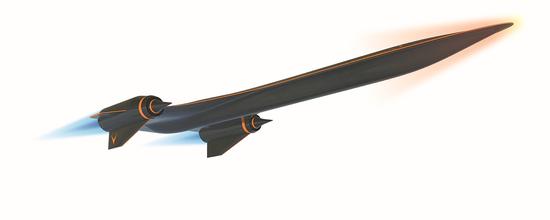Company developing supersonic aircraft

Cuantianhou will be nearly five times faster than a conventional jet. (Photo provided to China Daily)
Ultrafast model that debuts next year expected to fly at speed of 5,000 km/h
Private enterprises in China have shown their strong technological and engineering capability by manufacturing big rockets, advanced satellites and powerful drones. Now, one of them is determined to go further: making a superfast suborbital airliner that can tremendously shorten intercontinental travel time.
Lingkong Tianxing Technology, a Beijing-headquartered aerospace company, announced on Monday at a news conference in Chengdu, capital of Sichuan province, that its next-generation supersonic technology demonstrator is under research and development, and is scheduled to make its first test flight in 2026.
Deng Fan, the company's chief engineer, said at the conference that the prototype of the aircraft — called Cuantianhou, or Soaring Monkey — will be 7 meters long and weigh 1.5 metric tons. It will use a streamlined aerodynamic design that can effectively reduce air drag and improve flight efficiency.
He said the craft will be propelled by a state-of-the-art ramrotor detonation engine, which combines a rotary detonation engine, rotor compressor and ramjet technology.
The engine system, Jindou-400S, is also being researched at Lingkong Tianxing Technology. The 1.9-meter engine will weigh only 100 kilograms and will be able to create a thrust of at least 4,000 newtons.
"Using this engine will allow Cuantianhou to fly at a top speed of Mach 4.2, or about 5,000 kilometers per hour, which means the craft will be almost five times faster than a conventional jetliner," Deng said.
The futuristic craft will be launched by a carrier rocket, which will bring it to an altitude of about 20 km, and it will then continue to fly on its own. Most of its journey will occur in "near space", said the engineer, who declined to disclose how it will land.
Near space is the region of Earth's atmosphere between 20 and 100 kilometers above sea level, encompassing portions of the stratosphere, mesosphere and lower thermosphere. It is above the top altitudes of commercial airliners but below orbiting satellites.
Despite the ultrafast speed, Deng said passengers on such supersonic aircraft will be completely safe from acceleration effects.
The company's plan has become the latest endeavor by humans to revive the undying pursuit of ultrafast travel, which has long been symbolized by the legendary airliner Concorde.
Concorde, the first supersonic passenger-carrying commercial airplane, was built jointly by aircraft manufacturers in the United Kingdom and France. It was first flown in 1969 and was put into commercial operation in 1976. However, the epochal jetliner did not fit well in the civil aviation industry due to its loud noise, high fares, stringent requirements for airports and environmental impact.
If everything goes according to plan, the prototype for a commercial-use supersonic airliner named Dasheng — or Monkey King, a legendary hero in Chinese mythology — is expected to conduct its maiden flight in 2030. If that becomes reality, Dasheng will revolutionize the global air transportation sector, he added.
"Just imagine making an intercontinental flight within just two to three hours that you would now spend 10 hours or longer on," Deng said.
Internationally, enterprises in the United States and Europe have been racing to design and construct a new generation of supersonic airliners to meet the potential demand of fast intercontinental travel.
